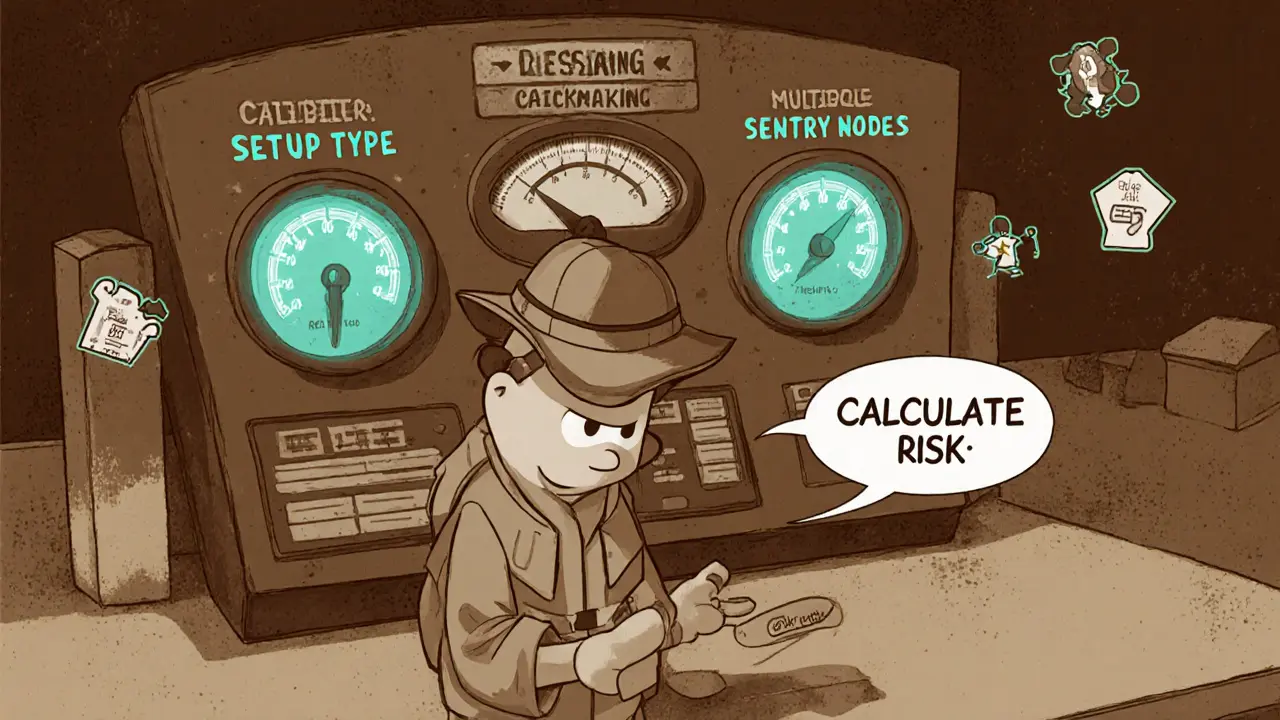Restaking Slashing Risk Calculator
Risk Assessment Result
Your calculated risk level for restaking slashing is:
When you hear Restaking is a process where staked assets are delegated to secondary protocols that offer additional yield on top of the base proof‑of‑stake rewards, think of it as stacking earnings. The upside looks tempting, but the downside-especially the restaking slashing risk-can wipe out both your principal and the extra gains if you’re not careful.
TL;DR
- Restaking adds layers of compliance; every layer brings its own slashing triggers.
- Common slashing causes: downtime, double‑signing, and consensus manipulation.
- Protect with remote signing, key sharding, and sentry‑node architectures.
- Monitor health metrics continuously; set automated alerts for missed blocks.
- Institutions should layer custody, governance, and compliance controls on top of technical safeguards.
What Exactly Is Slashing?
Slashing is a penalty mechanism built into proof‑of‑stake (PoS) blockchains that destroys a portion of a validator’s staked tokens when that validator breaches protocol rules. The loss is intentional-by making misbehavior costly, the network discourages attacks and protects overall security.
Typical violations include:
- Downtime: Validator nodes go offline and miss block‑proposal or attestation duties.
- Double‑signing: The same validator key signs two different blocks for the same slot.
- Surround voting (specific to Ethereum): Attesting to a block that “surrounds” another, which can alter perceived chain history.
On Ethereum, less than 0.04% of active validators have been slashed to date, and all recorded incidents stem from operational errors, not malicious attacks (data through February2024).
Restaking: Why It Can Amplify Slashing Exposure
Restaking means you lock your stake in a base PoS chain (like Ethereum) and then delegate that locked amount to one or more secondary protocols-liquid staking, yield‑optimizers, or cross‑chain bridges. Each additional service comes with its own rule set and slashing triggers.
When a validator is responsible for multiple services, a single misstep can breach more than one protocol’s slashing condition. For example, a missed heartbeat that would only cause a missed‑reward penalty on the base chain could become a full slashing event on a bridge that requires strict liveness guarantees.
Because documented restaking‑specific slashing incidents are scarce, the community relies on analogies from traditional staking. Consensys Staking, a major Ethereum‑staking provider, reports zero slashing events since the network’s launch, underscoring that robust operational practices can keep risk low-provided they’re extended to every layer of restaking.
Core Slashing Scenarios and Their Restaking Impact
Below is a quick cross‑reference of classic slashing causes and how they play out when you’re restaking.
| Cause | Base‑Chain Penalty | Restaking Amplification |
|---|---|---|
| Downtime (>X minutes) | Missed rewards; possible eviction | Secondary protocol may slash outright if service‑level agreement not met |
| Double‑signing | Stake burn (typically 0.5‑1%) | Multiple bridges could penalize the same event, compounding loss |
| Surround voting (Ethereum) | Stake burn + reputation hit | Cross‑chain validators may treat this as a security breach and slash |

Operational Guardrails: Mitigating the Risk
Technical safeguards should be the first line of defense. Here are the most effective tools, each tied to a specific slashing trigger.
- Remote signing - a process where the signing key never lives on the production node, reducing exposure if the node is compromised.
- Key sharding - splitting the validator key into multiple parts stored on separate machines; a single failure cannot produce a valid signature.
- Sentry nodes - lightweight front‑end nodes that forward traffic to the validator while keeping the validator’s private key isolated.
- Automated health monitoring: track block‑production latency, attestation coverage, and network connectivity in real time.
- Failover orchestration: pre‑configure backup instances in a different region or cloud provider, and enforce strict start‑up timing to avoid duplicate signatures.
Implementing these measures dramatically reduces double‑signing odds. In fact, the majority of slashing events to date were traced back to missing or mis‑configured failover scripts.
Institutional Considerations
When a fund, family office, or fintech platform enters restaking, the threat model expands beyond the validator node. Custody risk, regulatory exposure, and governance overhead become critical.
- Custody risk - keeping private keys in hot wallets raises the chance of compromise; hardware security modules (HSM) or multi‑sig vaults are recommended.
- Regulatory uncertainty - some jurisdictions treat staking‑as‑a‑service as a securities or banking activity, demanding AML/KYC and reporting.
- Governance - clear policies for key rotation, incident response, and delegator communication protect reputation after a slash.
Institutions should also diversify across multiple validators and even across chains to limit exposure to a single slashing event.
Checklist: Slashing‑Risk Management for Restakers
- Verify that the validator runs remote signing and never stores the signing key on a public node.
- Deploy at least two sentry nodes in distinct geographic zones.
- Implement key sharding and test reconstruction procedures quarterly.
- Set up real‑time alerts for missed blocks, high latency, or duplicate signatures.
- Document a formal incident‑response playbook that includes delegator notification within 24hours of a slash.
- Perform periodic compliance reviews for custody and regulatory alignment.
- Review protocol‑specific slashing parameters after every governance upgrade.
Future Outlook: Will Slashing Get Tougher?
As PoS networks grow in value, some experts warn that penalties may rise to deter larger attacks. However, excessive penalties could scare away validators, threatening network security. The sweet spot will likely be a dynamic model where slashing severity scales with the validator’s total stake across all restaked services.
Staying ahead means monitoring both the base‑chain’s governance proposals and any secondary protocol’s rule changes. A proactive stance-updating failover scripts, rotating keys, and revisiting risk models-keeps the restaking slashing risk manageable.

Frequently Asked Questions
What is the difference between downtime and slashing?
Downtime means a validator missed its block‑proposal or attestation duty, which usually results only in lost rewards. Slashing is a punitive burn of stake that occurs when the protocol detects a rule violation such as double‑signing or illegal attestations.
Can a single error trigger multiple slashes across different restaking services?
Yes. If a validator double‑signs, the base chain will slash, and any secondary protocol that treats double‑signing as a breach may also impose its own penalty, effectively compounding the loss.
How does remote signing protect against slashing?
Remote signing keeps the private signing key on a hardened, offline machine. The production node only receives signed messages, so even if the node is compromised it cannot produce a rogue signature that would be interpreted as double‑signing.
What monitoring metrics should I watch to avoid slashing?
Key metrics include block‑proposal latency, attestation coverage percentage, node uptime (preferably >99.9%), and duplicate‑signature alerts. Tools like Prometheus + Grafana or dedicated staking dashboards can visualize these in real time.
Should institutions delegate to a single validator or spread across many?
Spreading across multiple reputable validators reduces exposure to any single slash event and also protects against validator‑specific technical failures.


Alie Thompson
August 10, 2025 AT 09:04In the grand moral calculus of staking, the pursuit of profit must never eclipse the duty we owe to the network's integrity.
When we restake, we are not merely stacking tokens; we are amplifying our influence over consensus, and with that influence comes a heavy ethical burden.
It is incumbent upon every validator to treat slashing risk as a matter of communal trust rather than a private inconvenience.
The first principle is transparency: disclose your node configuration, remote signing arrangements, and any third‑party services you depend upon.
Transparency cannot be a mere tick‑box exercise; it must be accompanied by real‑time monitoring that anyone can audit.
Second, diversification is a virtue, for placing all your capital behind a single point of failure is tantamount to hubris.
Spread your delegations across reputable, independently operated validators to mitigate the impact of any one node being compromised.
Third, implement redundant failover mechanisms, because the absence of a backup plan is a reckless gamble with other people's stakes.
Redundancy should not be an afterthought but baked into your architecture, with automated alerts for any deviation from expected behavior.
Fourth, employ rigorous key management, including sharding and hardware security modules, so that a single key leakage does not doom the whole operation.
The community has seen too many tragedies where a lax key policy allowed an attacker to trigger massive slashing events.
Fifth, avoid remote signing unless it is absolutely necessary and you have verified the security of the remote service to the same standard you would demand of your own node.
If you must use remote signing, enforce multi‑signature schemes and enforce strict rate‑limiting on signing requests.
Sixth, maintain a culture of continuous learning, where operators regularly review post‑mortems and update their risk models accordingly.
The calculator provided in this post is a useful tool, yet it is only as good as the honest data you feed into it.
Do not be tempted to fudge parameters for a lower risk score, because the eventual penalty will far outweigh any temporary convenience.
Finally, remember that the ultimate goal of proof‑of‑stake is to secure a decentralized ledger, and any action that jeopardizes that objective is a betrayal of the very ethos we claim to uphold.
Let us therefore approach restaking with humility, diligence, and an unwavering commitment to the collective good.
Angela Yeager
August 12, 2025 AT 16:37Hey folks, happy to chime in with a quick rundown of practical steps you can take right after you fire up the calculator.
First, make sure you’ve got a solid monitoring stack – Prometheus paired with Grafana does the trick, and you can set alerts for missed heartbeats or double‑sign events.
Second, always enable a multi‑sig scheme for your signing key; it adds a tiny latency but saves you a ton of grief if one key gets compromised.
Third, if you run multiple validators, spread them across different geographic zones and cloud providers; this way a single outage won’t take out your whole stake.
Fourth, keep a hot‑wallet with just enough to cover fees and a cold‑wallet for the bulk of your stake – never keep the entire amount online.
Finally, run a regular dry‑run of your failover plan: simulate a node crash and watch how your backup picks up the load. It’s the best way to catch hidden gaps before a real slash hits.
vipin kumar
August 14, 2025 AT 18:37While most of us are busy tweaking UI sliders, the real danger lives in the shadows of the protocol.
Did you know that a single rogue validator can collude with a compromised remote signer to fabricate double‑signs without ever touching the network’s public logs?
The calculator doesn’t account for insider conspiracies, and that’s where the true slashing risk hides.
Keep an eye on unusual latency spikes and sudden changes in validator voting patterns – those are often the first whispers of a coordinated attack.
Also, make sure your node’s time sync is flawless; a drift of even a few seconds can be weaponized by a malicious entity to trigger slashing on a false premise.
Lara Cocchetti
August 16, 2025 AT 17:50People treat this calculator like a magic wand, but in reality it’s just a sheet of paper that can’t protect you from the looming specter of negligence.
If you trust a single validator blindly, you’re essentially handing over a vault key to a stranger who might decide to betray you for a quick payday.
Remember, the decentralized ethos is only as strong as the weakest link, and that link is often a poorly secured node.
So, diversify, monitor, and never, ever assume that a low risk score guarantees safety – it’s a false sense of security that will likely end in a hard lesson.
Mark Briggs
August 18, 2025 AT 14:17Nice calculator.
Millsaps Delaine
August 20, 2025 AT 07:57Allow me to elaborate on the nuanced interplay between economic incentives and protocol security, an area that many practitioners gloss over in favor of superficial metrics.
The theoretical underpinnings of slashing derive from game‑theoretic models where rational actors are presumed to act in self‑interest, yet these models often disregard the stochastic nature of real‑world network latency and the probabilistic distribution of validator uptime.
Consequently, a validator that appears low‑risk on paper may, in practice, experience micro‑outages that, when aggregated across epochs, introduce a non‑trivial probability of inadvertent double‑signing.
Furthermore, the cost‑benefit analysis of employing remote signing services must incorporate the hidden operational expenditures associated with secure key escrow and multi‑party computation, which are frequently under‑estimated.
One must also consider the entropy of the validator set; a highly correlated validator population amplifies systemic risk, thereby magnifying the impact of any individual slashing event.
In light of these considerations, the restaking risk calculator should be employed as a preliminary heuristic rather than a definitive verdict, and its outputs should be supplemented with rigorous stress‑testing and adversarial simulations.
Vaishnavi Singh
August 21, 2025 AT 22:50From a philosophical standpoint, the act of restaking can be viewed as an extension of one’s commitment to the collective digital commons.
Yet, this commitment is only meaningful if it is accompanied by a vigilant awareness of the systemic vulnerabilities inherent in the network’s architecture.
Thus, reflective introspection should guide the deployment of safeguards, ensuring that personal gain does not eclipse communal responsibility.
Chris Hayes
August 23, 2025 AT 10:57What I like about the calculator is its straightforward scoring, but the real mastery comes from interpreting those numbers in context.
For instance, a score that lands you in the “medium‑risk” bracket can be dramatically improved by simply adding a monitoring webhook that triggers on validator downtime.
Also, don’t underestimate the power of community audits – having peers review your configuration can expose blind spots you missed. Overall, combine the tool with proactive operational hygiene, and you’ll keep your stake safely out of the slasher’s crosshairs.
Samuel Wilson
August 24, 2025 AT 20:17Building on the previous point, a disciplined approach to risk mitigation resembles a well‑structured training regimen.
Begin each week by reviewing your alert logs, then allocate a dedicated window to run failover drills.
Encourage your team to simulate edge‑case scenarios, such as a sudden loss of remote signing capability, and record the response times.
This systematic practice not only improves resilience but also instills a culture of continuous improvement among your operators.
Christina Norberto
August 26, 2025 AT 02:50While the aforementioned suggestions are commendable, one must acknowledge that excessive bureaucracy can stifle innovation.
Over‑engineering monitoring frameworks may lead to alert fatigue, causing critical events to be ignored.
Thus, a balance must be struck between thoroughness and operational efficiency, ensuring that safety measures remain both effective and manageable.
Aditya Raj Gontia
August 27, 2025 AT 06:37From an engineering perspective, the implementation of a layered defense architecture-comprising multi‑sig thresholds, hardware security modules, and decentralized watchdog services-provides a robust mitigation matrix against slashing vectors.
Neglecting any one of these strata can create an exploitable attack surface, as evidenced by recent chain incidents where single‑point failures precipitated substantial token losses.
mannu kumar rajpoot
August 28, 2025 AT 07:37It’s interesting how many of us overlook the geopolitical dimension of validator placement; aligning nodes with diverse jurisdictions can reduce exposure to regulatory clampdowns that might otherwise trigger forced exits and consequent slashing.
Moreover, independent audits from cross‑border security firms add an extra layer of credibility, deterring malicious actors who thrive on opaque infrastructures.
Tilly Fluf
August 29, 2025 AT 05:50Indeed, incorporating a multi‑jurisdictional strategy not only diversifies risk but also fosters a more resilient network topology.
By ensuring that no single legal framework can unilaterally impact the validator set, we safeguard against both external and internal threats.
It’s a best practice worth formalizing in any comprehensive risk management policy.
Darren R.
August 30, 2025 AT 01:17Let us not forget, dear colleagues, that the elegance of a well‑engineered staking operation lies not solely in technical safeguards but also in the aesthetic harmony of its design.
When every component-monitoring, key management, failover-coalesces into a seamless whole, the system transcends mere functionality and becomes a testament to our collective ingenuity.
Thus, we should aspire not merely to avoid slashing, but to craft a staking architecture that sings with the poetry of security.
Hardik Kanzariya
August 30, 2025 AT 17:57Absolutely, Darren’s point about elegance resonates deeply.
In practice, I’ve found that pairing concise alerting rules with clear runbooks makes the whole process more approachable for newer team members.
When the documentation mirrors the simplicity of the system, onboarding becomes smoother and the risk of human error drops significantly.
Shanthan Jogavajjala
August 31, 2025 AT 07:50While I appreciate the emphasis on documentation, let’s keep in mind that excessive verbosity can obscure critical details.
Striking a balance between thoroughness and brevity is key; a well‑structured cheat‑sheet often outperforms a sprawling manual in emergency scenarios.
Jack Fans
August 31, 2025 AT 18:57Great insights from everyone! I’ll take the suggestion to create a concise cheat‑sheet and combine it with the detailed runbook.
That way we get the best of both worlds – quick reference during incidents and deep dives when we have time to refine our processes.